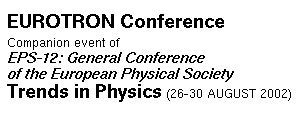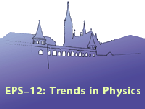 |
 |
 |
The information revolution, which has surprised us over the last few decades, has occurred due to the restless exponential growth of information amount that can be processed, stored, and transferred per time and area unit of relevant devices. Spin electronics (spintronics) is a young interdisciplinary field of nanoscience. Its rapid development, like that of competing new branches of electronics molecular electronics, bioelectronics, electronics of polymers, , has its roots in the conviction that the progress that is being achieved by miniaturization of active elements (transistors and memory cells) cannot continue forever. Therefore, the invention of future information technologies must involve new ideas concerning the design of both devices and system architecture. The main goal of spintronics is to gain knowledge on spin-dependent phenomena, and to exploit them for new functionalities. Hopes associated with spintronics stem from the well-known fact that the magnetic fields present in the ambient world are significantly weaker than the electric fields. For this reason magnetic memories are non-volatile, while memories based on the accumulated electric charge (dynamic random access memory DRAM) require a frequent refreshing. Todays research on spintronics involves virtually all material families, the most mature being studies on magnetic metal multilayers, in which spin-dependent scattering and tunneling are being successfully applied in reading heads of high-density hard-discs and in magnetic random access memories (MRAM). However, in the context of spintronics particularly promising are ferromagnetic semiconductors, which combine complementary functionalities of ferromagnetic and semiconductor material systems.
In the talk, recent progress in semiconductor spintronics will be reviewed emphasizing findings important for either classical or quantum information devices. In particular, the demonstration of isothermal and reversible switching of magnetization by light and the electric field in ferromagnetic semiconductors will be described. Various schemes enabling injection and manipulation of electronic or nuclear spins in non-magnetic semiconductors and their nanostructures will be discussed. The role of confinement and dimensionality will be presented together with prospects for coherent control of single spins in solid-state environment.
References
For reviews on spintronics, see, e.g., T. Dietl, Semicond. Sci. Technol. 17 (2002) 377; Acta Phys. Polon. A 100, Suppl. (2001) 139, www.arXiv.org/abs/cond-mat/0201279; S.A. Wolf et al., Science 294 (2001) 1488; H. Ohno, F. Matsukura, and Y. Ohno, JSAP International, No. 5, January 2002, pp. 4-13, www.jsapi.jsap.or.jp.
The following files are available:
- abstractdietl.pdf [9722 bytes]
- abstractdietl.doc [40448 bytes]
Eurotron Conference is supported by European Commission, High-Level Scientific Conferences